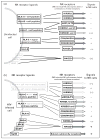Innate immune responses in primary HIV-1 infection
- PMID: 19372942
- PMCID: PMC2696284
- DOI: 10.1097/COH.0b013e3282f2bce7
Innate immune responses in primary HIV-1 infection
Abstract
Purpose of review: Events occurring in acute HIV-1 infection are now recognized to be critical determinants of the subsequent disease course. Innate responses constitute the first line of defence against pathogens, and also play a key role in triggering the early adaptive response; as such, the innate responses activated in acute HIV-1 infection and their contribution to control of viral replication or disease pathogenesis are the focus of much current research. We review recent advances in this area.
Recent findings: Dendritic cell subsets can play pleiotropic roles in acute HIV-1 infection, with in-vitro studies illustrating that HIV-dendritic cell interactions may have outcomes as diverse as virion destruction, virus dissemination, T-cell triggering or subversion of dendritic cell functions. Natural killer cells can be activated in acute HIV-1 infection, and mounting evidence suggests that they contribute to determining the ensuing course of disease; however, much remains to be learned about how they mediate their effects.
Summary: The importance of innate responses as determinants of the outcome of HIV infection is increasingly evident, but more work is needed to understand how innate immunity can be harnessed to combat this infection.
Figures


Similar articles
-
Innate immunity in acute HIV-1 infection.Curr Opin HIV AIDS. 2011 Sep;6(5):353-63. doi: 10.1097/COH.0b013e3283495996. Curr Opin HIV AIDS. 2011. PMID: 21734567 Free PMC article. Review.
-
Innate immunity against HIV: a priority target for HIV prevention research.Retrovirology. 2010 Oct 11;7:84. doi: 10.1186/1742-4690-7-84. Retrovirology. 2010. PMID: 20937128 Free PMC article. Review.
-
Natural killer cells during acute HIV-1 infection: clues for HIV-1 prevention and therapy.AIDS. 2022 Nov 15;36(14):1903-1915. doi: 10.1097/QAD.0000000000003319. Epub 2022 Jul 9. AIDS. 2022. PMID: 35851334 Free PMC article. Review.
-
HIV Exploits Antiviral Host Innate GCN2-ATF4 Signaling for Establishing Viral Replication Early in Infection.mBio. 2017 May 2;8(3):e01518-16. doi: 10.1128/mBio.01518-16. mBio. 2017. PMID: 28465428 Free PMC article.
-
Nucleotide oligomerization and binding domain 2-dependent dendritic cell activation is necessary for innate immunity and optimal CD8+ T Cell responses to influenza A virus infection.J Virol. 2014 Aug;88(16):8946-55. doi: 10.1128/JVI.01110-14. Epub 2014 May 28. J Virol. 2014. PMID: 24872587 Free PMC article.
Cited by
-
Acute HIV-1 Infection.N Engl J Med. 2011 May 19;364(20):1943-54. doi: 10.1056/NEJMra1011874. N Engl J Med. 2011. PMID: 21591946 Free PMC article. Review.
-
Induction of Potent and Long-Lived Antibody and Cellular Immune Responses in the Genitorectal Mucosa Could be the Critical Determinant of HIV Vaccine Efficacy.Front Immunol. 2014 May 8;5:202. doi: 10.3389/fimmu.2014.00202. eCollection 2014. Front Immunol. 2014. PMID: 24847327 Free PMC article. Review.
-
Dopaminergic Regulation of Innate Immunity: a Review.J Neuroimmune Pharmacol. 2017 Dec;12(4):602-623. doi: 10.1007/s11481-017-9749-2. Epub 2017 Jun 3. J Neuroimmune Pharmacol. 2017. PMID: 28578466 Review.
-
Monocyte/Macrophage-Mediated Innate Immunity in HIV-1 Infection: From Early Response to Late Dysregulation and Links to Cardiovascular Diseases Onset.Virol Sin. 2021 Aug;36(4):565-576. doi: 10.1007/s12250-020-00332-0. Epub 2021 Jan 5. Virol Sin. 2021. PMID: 33400091 Free PMC article. Review.
-
Cystatin F Depletion in Mycobacterium tuberculosis-Infected Macrophages Improves Cathepsin C/Granzyme B-Driven Cytotoxic Effects on HIV-Infected Cells during Coinfection.Int J Mol Sci. 2024 Jul 26;25(15):8141. doi: 10.3390/ijms25158141. Int J Mol Sci. 2024. PMID: 39125711 Free PMC article.
References
-
- Lakshmanan V, Alter G et al. Biology of plasmacytoid dendritic cells and natural killer cells in HIV-1 infection. Curr Opin HIV AIDS. 2007;2:189–200. A recent detailed review of pDC–HIV-1 interactions. - PubMed
-
- Takaori-Kondo A. APOBEC family proteins: novel antiviral innate immunity. Int J Hematol. 2006;83:213–216. A comprehensive review summarizing the APOBEC family of proteins. - PubMed
Grants and funding
LinkOut - more resources
Full Text Sources
Research Materials
